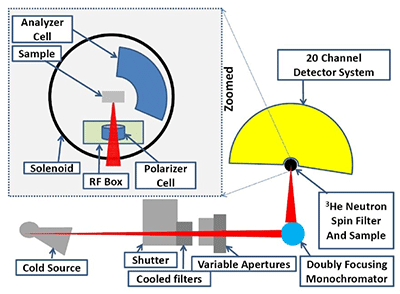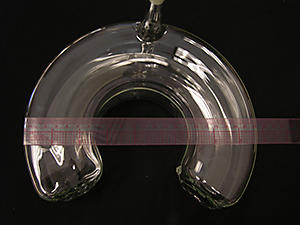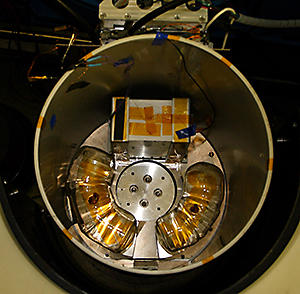Summary
The capabilities of many neutron scattering instruments are greatly enhanced by neutron polarization analyzers that can cover a wide angular range. This project developed polarizing gas cells able to cover a large angular range.
Description

Figure 1: A top view of the MACS instrument, with an enlarged view of the spin filter system: the neutron beam (red) passes through the neutron-compatible solenoid and is polarized by a 3He spin filter. After being scattered from a sample (located in a cryostat that is lowered into the solenoid), two curved 3He cells analyze the polarization of the widely scattered neutrons.
We have developed a polarizer-analyzer-spin flipper system based solely on 3He spin filters on the Multi-Axis Crystal Spectrometer (MACS) at the NIST Center for Neutron Research. The compact system is housed by a 36 cm diameter, vertical solenoid. Neutrons are polarized by transmission through a polarized 3He cell and the polarization of neutrons scattered into a wide angular range are analyzed by two 3He spin filter cells. Nuclear magnetic resonance(NMR) is used to flip the 3He polarization of the 3He polarizer, thereby inverting the polarization of the incoming neutron beam. The radio-frequency solenoid for the NMR is enclosed in a shielded box to avoid perturbing the 3He polarization in the analyzer cells. A description of the apparatus can be found in Q. Ye et al, Physics Procedia 42, 206-212(2013). In collaboration with the NCNR, the system has been employed for four neutron scattering experiments on MACS.


A key technical challenge was development of the analyzer cells. The NIST glass/optical shop developed a method for fabricating wide-angle cells from the boron-free aluminosilicate glass preferred for neutron spin filters. We have successfully obtained relaxation times of 100 h to 400 h in these cells and 3He polarization values of up to 80 %. The wide-angle analysis capability has become a new addition to the highly successful NCNR spin filter program, which is a spin-off from past PML work.
This capability will greatly enhance fundamental and applied studies of magnetic materials.

